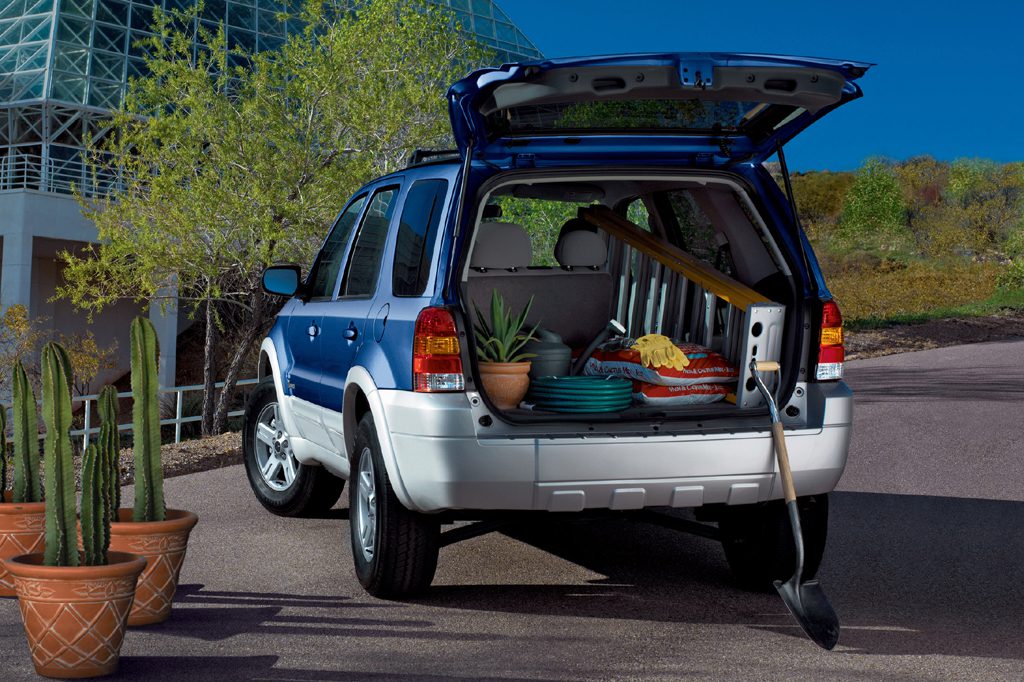| Compact SUV; Built in USA |
|
|
| Good condition price range: $5,500 – $27,000* |

2006 Ford Escape

2006 Ford Escape

2006 Ford Escape
| Pros: |
|
| Cons: |
|
By any name, these compact SUVs are solid, spacious, practical, and pleasant enough to drive. In 2005-06, they ranked as Best Buys. Competitive new-car pricing has made them high-value alternatives to some larger truck-based SUVs that use more gas and don’t have significantly more interior space. Still, these are among the oldest designs in the compact-SUV field. Until the Mariner offered a gasoline/electric powertrain, the Escape Hybrid was America’s only compact SUV hybrid, and it adds fuel savings to Escape’s other attributes. Though base new-vehicle prices have been relatively steep, an Escape doesn’t compromise performance. Escape resale values have been lower than those for most Ford products, which can be good news for used-vehicle shoppers.
Overview
Introduction of a gas/electric Hybrid version topped changes to Ford’s smallest SUV. Again offered with front- or all-wheel drive, the Escape also got a larger base engine, freshened styling, and additional safety features.
This five-passenger, four-door wagon had a rear liftgate with separate-opening glass. Replacing a 127-horsepower 2.0-liter four-cylinder as the base engine was a 153-hp 2.3-liter four-cylinder.
Four-cylinder Escapes could have a manual transmission or, new for 2005, optional automatic. (Prior four-cylinder models came only with manual shift.) A 200-hp V6 with automatic transmission also was available.
The Hybrid had a four-cylinder gas engine, assisted by an electric motor, for a combined 155 horsepower. Its electric motor helped save fuel by powering the Hybrid at low speeds and assisting the gas engine during acceleration. No plug-in charging was ever required; instead, the system recharged the motor’s batteries when coasting or decelerating. The Hybrid used a continuously variable transmission (CVT) that functioned like an automatic but had a near-infinite number of ratios.
All models came with front-wheel or all-wheel drive; the AWD system did not include low-range gearing. For 2005, Escape’s automatic-transmission shift lever was mounted on the floor console rather than the steering column. Antilock braking, previously optional, now was standard.
Newly optional were head-protecting curtain side airbags for both seating rows. They were designed to deploy in side impacts and rollovers. Escapes also got revised front and rear styling. Ford said it had more sound insulation, too.
Mazda’s Tribute and the new 2005 Mercury Mariner were similar to Escape, but didn’t offer a hybrid version at this time. Rivals included the Honda CR-V, Jeep Liberty, and Subaru Forester.
Yearly Updates
| 2006 Escape Little changed on Escapes in the 2006 model year. |
| 2007 Escape Once again, little was new for the Escape, but a somewhat reworked 2008 model arrived in spring of 2007. |
| 2008 Escape The 2008 Ford Escape was updated with freshened exterior and interior styling, new features, and lower prices. It was nearly identical in size and had the same powertrains as the 2001-2007 version. |
| 2009 Escape Escape “muscled up” for 2009. Newly standard on four-cylinder models was a 171-hp 2.5-liter four to replace a 153-hp 2.3-liter unit, and the optional 3.0-liter V6 gained 40 hp for a total of 240. |
| 2010 Escape The 2010 Ford Escape received some new features, including a rearview camera. Also new was MyKey, which allows owners to program a key that can limit the vehicle’s top speed and audio volume. Another new feature was Ford’s Active Park Assist, which uses ultrasonic sensors to help automatically guide the vehicle into a parallel-parking space. |
| 2011 Escape The 2011 Ford Escape saw no major changes. |
| 2012 Escape There were no changes to the 2012 Ford Escape in its final model year in this form. |
